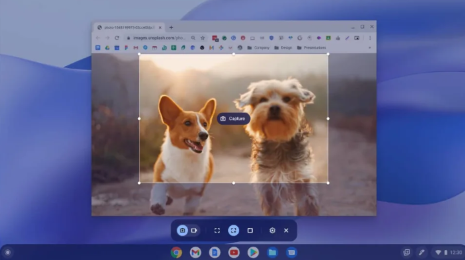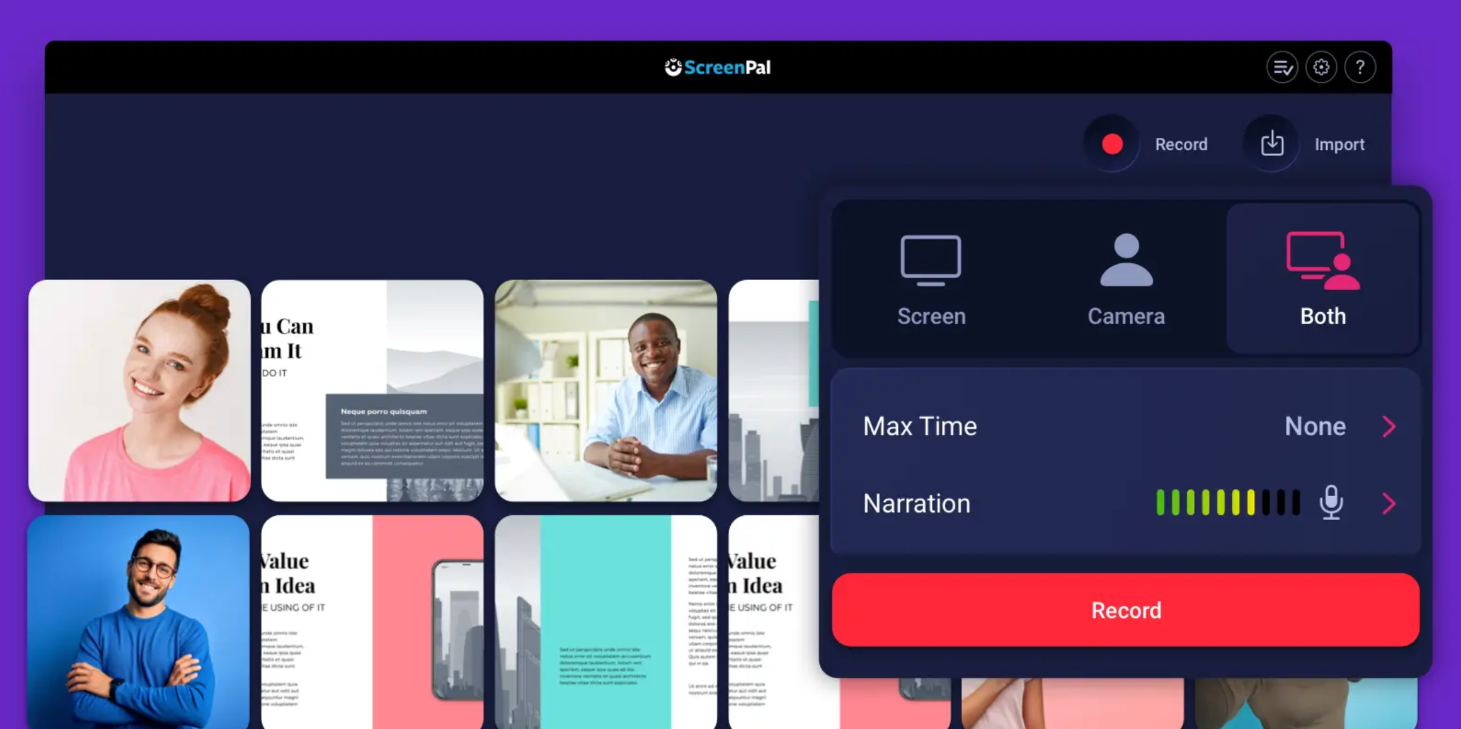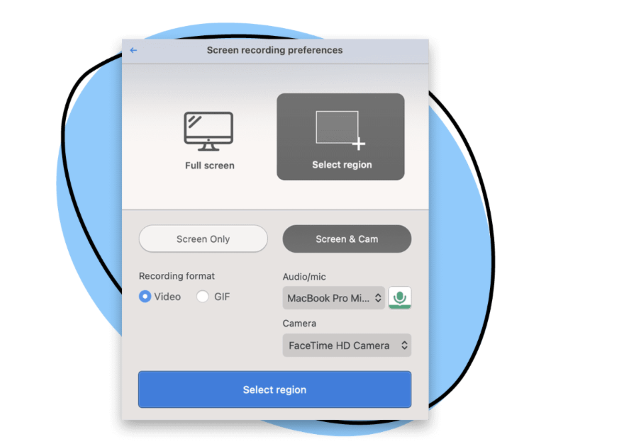How to take a screen capture or record video using a Chromebook
Chromebooks are great for users who want a lightweight, portable, and nimble option for word processing, web surfing, and browser-based tools and tech. But did you know that with the right tools, your Chromebook can help you create versatile, professional-looking videos to share with anyone?
The Chromebook has a few basic screen capture features built into Chrome OS. Its features allow users to capture a still image or a simple video recording. Still, adding a tool like Loom makes producing great video, webcam, and audio presentations fast and easy (without bogging down your computer).
Check out options for recording and screen capture with your Chromebook, and learn why Loom offers Chrome users the most free features in a processor-friendly Chrome extension.
Try Loom for Free TodayHow to take screen captures on a Chromebook
Chromebook allows you to capture a still image of your screen. Depending on your Chromebook model, you can grab a screenshot by clicking the Screenshot key or pressing Shift + Ctrl + Show Windows. If your Chromebook doesn’t have a Show Windows key, use Ctrl + Shift + F5. You can take a full-screen screen capture or a portion of your screen.
Where is the screenshot key on Chromebook?
The screenshot key on Chromebook allows users to take still images of a screen. With the added features of Chromebook, users can also record video through the Screenshot key shortcuts and on-board screen capture tools. You can take a screen capture (also known as a screenshot) or video content using keyboard shortcuts. The Screenshot key on Chromebooks is typically located at the top of the keyboard. It’s labeled either “Screenshot” or “Show Windows.” Clicking this key (usually along with the Ctrl key depending on your model) captures a still image of the current screen.

Does Chromebook have a screen capture tool?
Chromebook offers some native screen capture features for capturing a quick video. It’s worth noting that Chromebook’s screen capture is basic, allowing you to capture images and either a whole-screen video or part of the screen of your desktop. You can also record audio by toggling microphone settings; however, the screen capture tool defaults to non-audio recording.
Chromebook saves the completed media to your desktop, which can present a challenge for storage-light models. Also, there’s no streamlined way to edit or send the video once complete. You’ll need separate editing software tools, video hosting, or email applications for those.

How to take a partial screen capture
Chromebook allows you to tailor your screenshot parameters. To take a partial screen capture: Press Shift + Ctrl + Show Windows, then click and drag to the desired size. To access more screen capture features: Press Shift + Ctrl + Show Windows, then select a feature from the toolbar.

Using a screen recording tool like Loom: The step-by-step process
The Chrome screen recorder from Loom opens up many possibilities for creating polished, professional videos from your Chromebook.
Loom offers several ways to get started with screen recording. Chromebook users can record using the web browser or a Chrome extension. While the still image screen capture function is only available with the Windows or Mac Desktop app, you can still record full audio, webcam, and screen footage simultaneously in Chrome.
To record a video using Loom, follow these simple steps:
- Sign up for a Loom account—it’s fast and free!
- Download the Loom Chrome extension.
- Log into your new Loom account. You can use your Google credentials.
- Select the type of video you’d like to create.
- Click the Record button (Start Recording) to begin your Loom video.
- When your video is complete, hit the Stop button in the toolbar to stop recording and save the file to your Loom account.
- Edit your video using the editing and annotation tools. The Chrome extension offers many of Loom’s editing and enhancement features.
Tips for taking a screen video recording on a Chromebook
The Screenshot key can help you capture a still image, but by changing the settings in the screen capture window, you can also capture basic video.
To record your screen on Chromebook, press Ctrl + Shift + Show Windows. At the bottom-right corner of the screen, select Screen record from the window.
The basic recording feature gives you some options for recording. You can record:
- The entire screen
- Partial screen
- A specific window
Once the recording is complete, select Stop recording to end your video.
7 resources for taking screen video recordings on a Chromebook
There are many options for third-party recording tools to help make the most of your content creation on a Chromebook. We’ve compiled this list of the best resources for Chromebook screen recording, complete with pros, cons, and pricing details to help you learn about your options.
Each of the below entries offers a Chrome extension for its platform, making it easy to record video without downloading a larger desktop app.
1. Loom
Loom is the first cloud-based platform to offer screen recording capabilities from any web browser, Windows or Mac desktop, or mobile device running iOS or Android. The cloud-based and Chrome extension versions of the screen recording tool make recording video and audio with your Chromebook simple and effective. It offers the most robust free-tier features of any tool on the market.

Beyond basic screen capture, Loom offers many tools for creating professional-looking videos with all the enhancements and features of professional video editing software. Its communication, feedback, and delivery features also make it easy to share your content with an individual or a group, directly or embedded in a webpage or social platform.
Pros
- Loom offers advanced features with its paid plans and add-ons, such as automatic filler word removal (do away with the umms and ahhs), backgrounds, and video stitching.
- With Loom, you’ll know when a recipient watches your video.
- For a small fee ($4 per user, billed annually), users can take advantage of AI features, including video chaptering, auto-generated captions and titles, and chapter summaries.
- The platform can record screen, webcam, and audio simultaneously with Loom, with the option for a picture-in-picture webcam “bubble” to personalize your presentation.
- Loom has advanced tools for replying to videos with comments and reactions, supporting easy asynchronous communication with your recipient.
- The free plan offers generous video creation and storage capabilities: Free plan users can record 25 Looms total of up to 5 minutes each.
- All plans have access to unlimited transcriptions for videos.
Cons
- The Chrome OS is incompatible with the Loom desktop app, but users still have access to many of Loom’s award-winning features through the Google Chrome extension. You can learn more about Loom’s minimum performance requirements here.
- 4k recording is available only on paid plans through the desktop app. However, Chrome extension users can still record in professional-looking 1080p resolution.
2. ScreenPal (formerly Screencast-o-matic)
This free screen recording platform offers quick and easy ways to create and send video messages from our screen or webcam. The tool features audio narration, background music, and captioning for creating more polished content. It also offers basic editing and annotation tools, and cloud-based hosting to save videos without bogging down your Chromebook.

Pros
- The platform supports unlimited recording and storage for videos in the cloud.
- Basic editing tools allow you to trim recordings for a more professional presentation.
- Music and captioning features allow users to enhance their content easily.
- Some plans on ScreenPal enable personalized branding features.
Cons
- The editing suite in ScreenPal is somewhat limited compared to other options.
- Video heatmaps, advanced stock footage, and the music library are only available with the Max plan.
- Branding customization, in-video links, CTAs, and cloud backups are only available with the mid-tier Premier plan.
- There is no free plan for ScreenPal; pricing starts at $2/user/month (annually) for education users and $3/user/month for business users.
3. Clip by ClickUp
The ClickUp platform includes the ClickUp Clip stand-alone Chrome extension for easily recording and sharing videos with a “free forever” tool. The app also offers a task function, allowing users to create a task from recorded content, add descriptions, and assign tasks to team members.

Pros
- Clip provides a useful, integrated recording option for ClickUp users.
- The tasks feature is useful for communicating with teams, assigning tasks, and collaborating asynchronously.
- Record content from a screen or browser tab outside of ClickUp and share it with an easy-to-use link—no downloading required.
Cons
- Clips are part of your 100MB allotted storage space on the free version of ClickUp.
- Unlimited storage and integrations are only available with the paid tiers of the tool.
- Advanced public sharing requires the $12/user/month Business tier.
4. Wistia Soapbox

Pros
- Training-first model is ideal for team or group leaders and educators looking to share instructional content.
- Wistia offers intuitive features that make it easy to create basic screen recordings.
- The platform has high-definition recording options for professional-looking videos.
- Users can toggle between screen and webcam for a more cinematic video presentation.
Cons
- There are plans to integrate the current Chrome extension into the main Wistia platform in 2024, meaning Chromebook users who want the extension will need to download the app or use the web-based version.
- The editing tools available in Wistia are less robust than other market options.
- Soapbox is part of the Wistia platform, so you must sign up for a plan even if you only need the screen recording tool.
5. Zight (formerly CloudApp)
This screen recording and screen capture tool offers an experience similar to Loom. The tool offers some of the same fun features, such as annotations and a GIF generator, giving users plenty of ways to express themself through their content.

Pros
- The easy and intuitive UI allows you to create videos without a steep learning curve.
- Zight has simultaneous audio and video recording so that you can narrate your content without post-editing.
- Shareable links make it easy to share your content with others.
- You can use drawing tools to annotate and highlight features, like your cursor or a specific area of the video in your content.
Cons
- Free plans have a video time limit of 90 seconds.
- Transcription features are only available through the Enterprise plan, which may be out of budget for casual or small business users.
- Editing tools are relatively basic and may not meet the demands of professional or detailed video production.
- Integration options for Zight are limited.
6. Screencastify
This online and extension-ready video recording and editing tool is mostly geared toward the education market but offers solid functionality for Chromebook users who want to capture and edit video. Its primary user base creates instructional videos, feedback sessions, demos, tutorials, and video-based classroom assignments to share through the platform.
Like all the entries on this list, Screencastify offers a Chrome extension for access to advanced recording features without the bulk of a desktop download.

Pros
- The platform works well with Google products, including Google Education.
- It offers communication features for sharing and commenting on videos.
- The product offers annotation and markup features for enhancing video content.
- Screencastify has a free version for trials and light-duty users.
Cons
- Unlimited recordings and assignments are only available with paid plans.
- Free plans insert a watermark into your content.
- The editing tools are sufficient but don’t offer next-level features.
7. Fusebase (formerly Nimbus)
Nimbus Capture (also called NCapture, now part of Fusebase), is a module of the larger Nimbus platform. The screen capture and video editing tool allows users to capture screen and webcam footage, trim and crop content, and convert the finished video into GIF or MP4 content.

Pros
- Nimbus integrates seamlessly with the rest of the Nimbus platform, but the Chrome extension can operate as a stand-alone tool.
- The tool offers competitive recording quality for professional-looking content.
- The still image capture function allows users to export images to PDF, JPG, and PNG.
Cons
- Nimbus has limited customization options for enhancements like fonts and sizing.
- The tool offers basic editing tools that aren’t competitive with other options on the market.
- The free version of Nimbus has recording time limits for content.
Loom helps Chromebook users make the most of screen capture
The Loom extension and app allow everyone to record fast, easy videos from anywhere. So, whether you use Chrome, Apple or Android devices—or Windows and Mac desktops—you’re just a download away from crisp, professional videos with editing, enhancements, and feedback tools.
Communicate with everyone—from every device.
Try Loom for Free Today